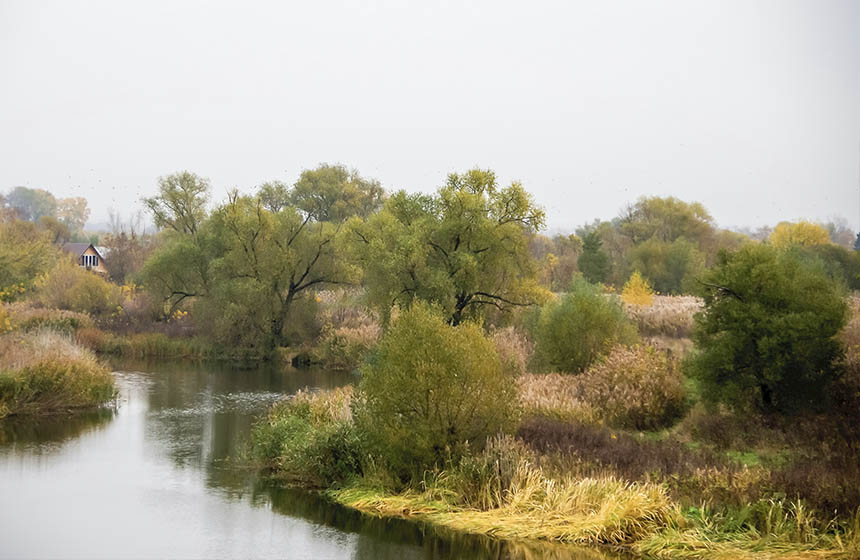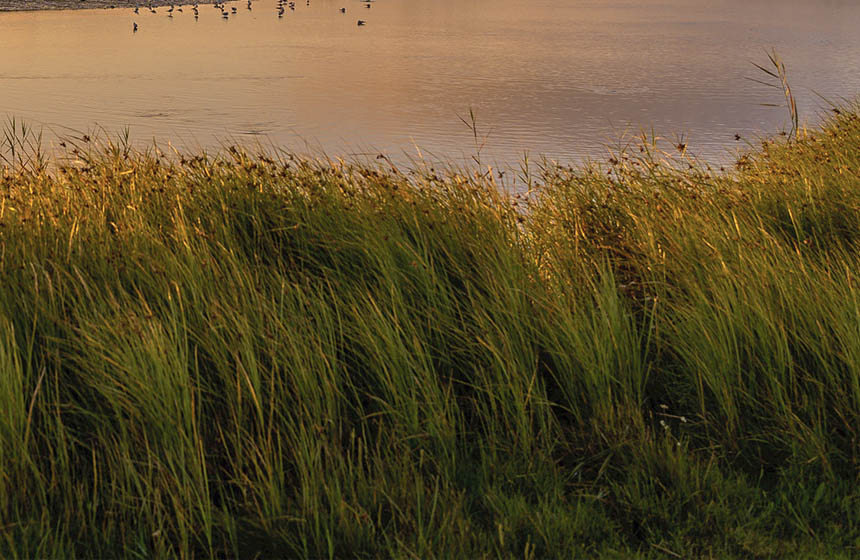The Great Fen
The Great Fen project aims to restore wetland habitats and implement new farming methods that address climate mitigation and adaptation, enhance biodiversity, and benefit people.
Nature-based intervention:
Wild fen habitats in the Great Fen drastically decreased due to drainage and farming. Although reclaimed fenland is prime agricultural land, it produces very high carbon dioxide emissions as the peat dries out and oxidises. In 2001, five organisations formed the Great Fen Steering Group and started a landscape-scale project to restore 14 square miles of land (3,741 hectares) to wild fen, connecting two National Nature Reserves (1). Land has been gradually purchased over 20 years, reaching a total of 4,000 acres (1,620 hectares) today. Arable fields are being gradually restored into grasslands through grazing and hay cutting and finally restored to wetlands (2). Clay banks were also constructed along the Woodwalton Fen reserve boundary to enhance water retention on the reserve (3). Gradual recovery has resulted in a mosaic of habitats across the Great Fen including wetlands, meadows, woodlands, bogs, wet heaths, and wild fen, all at different stages of restoration, together with some patches of ancient fen habitat.
In 2023, a new system of wet farming (paludiculture) was launched across a 120 hectare area as part of a 5-year National Lottery Heritage project (4). This system of farming with a higher water table is expected to reduce the high emissions from crop production on peatland, with additional benefits for wildlife, water quality, and people.
Overview of context:
Drainage of fens to create farmland in the 17th century destroyed 99% of wild fen habitat in the area (1). Only two isolated ancient fen habitats remained, Woodwalton Fen (208 hectares) and Holme Fen (266 hectares). Woodwalton Fen was preserved as it was purchased by Charles Rothschild in 1910 and designated as a National Nature Reserve in 1954. Holme Fen remained as the area was too wet for farming, though due to drainage of adjacent areas, the Holme Fen National Nature Reserve dried out (5).
Case effectiveness on
Climate change
The project aims to increase carbon storage and reduce the high emissions from farming on peat soil through habitat restoration and the use of wet farming (paludiculture) techniques for land currently under arable use. Cropland on peat soil releases an average of 39 tonnes CO2 equivalent per hectare per year, but restoring this to rewetted fen can reduce this to 6 tonnes, and near-natural fen will absorb 0.6 tonnes (22). Converting arable fields to grasslands as a first step in restoration immediately reduces the loss of peat due to wind erosion, estimated as 2cm per year (23). Wet farming, the production of crops on re-wetted peatlands, is believed to reduce carbon emissions compared to cultivation on drained peat soil (4). A field trial was implemented in 2021 to test a range of crops that can grow in wet conditions, in partnership with local farmers, food producers and landowners (6). After successful three-year trials, these wet farming techniques are being used to grow bulrush (Typha latifoli) and sphagnum moss on Speechly Farm (4). The UK Centre for Ecology and Hydrology is measuring greenhouse gas flux data on these sites to build on scientific evidence for their impact on greenhouse gas emissions. Overall, it is estimated that halting peat degradation across the Great Fen would save 325,000 tonnes of CO2 from being released each year (1).
The project has modelled future climate change impacts when designing new wetlands, aiming to store excess water during heavy rainfall for use during summer droughts (23). Flood risks are high in the flat, low-lying fens, with huge floods in 1947 and 1953 (7), but storing more water on site will reduce the risk of flooding to surrounding farms, villages, and towns (1). However, although Woodwalton Fen stores water during heavy rainfall (8), it is not large enough to cope with extreme rainfall events that are predicted to increase in frequency in future. Additionally, the flood water contains nitrates and phosphates from surrounding farmland, which can pollute water at the reserve. As such, two Great Fen partners are collaborating to create new water storage areas elsewhere within the Great Fen. Meanwhile, flood mitigation benefits are already reported because water is no longer pumped out into the river system during high rainfall events, and the restored areas have also been able to store excess water when needed (23).
Ecosystem health
Ecological effect: PositiveWoodwalton Fen is a National Nature Reserve, a Ramsar site, a Site of Special Scientific Interest and a Special Area of Conservation. It provides habitat for over 1000 beetle and 900 moth and butterfly species, 400 species of wildflower (including the Fen Woodrush, which is only found here), as well as marsh harriers and kingfishers (9). Holme Fen is a National Nature Reserve and a Site of Special Scientific Interest. It consists of silver birch woodland on the site of a huge former lake, with remnants of the original fen habitat around two remaining lakes. These have islands and shallow banks which encourage the presence of birds, dragonflies, and over 500 types of fungi (10).
The new habitats created as part of the project including meadows, reedbed, woodland, and open water, are expected to attract otters, water voles, snipe, lapwing, dragonflies, butterflies, moths, water beetles and other wildlife (11). Breeding lapwings, visiting cranes and avocets were recorded for the first time at the restored Darlows Farm in 2007, followed by Whooper and Bewicks swans in 2011 (), and rare wetland plants started to spread into the new wetlands in 2010 (12). The polecat, once trapped to extinction in Britain and recolonising since the 20th century, was sighted in 2022 within the Great Fen.
Socioeconomic outcomes
Local heritage was a key part of the project, and helped to engage residents who were less interested in wildlife. Staff and volunteers from the Great Fen worked with the Ramsey Rural Museum and students from Abbey College to create booklets and a DVD of local stories and memories of the fens, by interviewing many elderly local people (16).
Prior to the project, arable land in the Great Fen was used to farm onions and root vegetables. Given that tilling the soil results in peat erosion, the project will move to become a low-intensity food producer, producing beef, lamb, and hay for livestock feed (11). In addition, bulrush crops harvested as part of the paludiculture harvests will be used by Saltyco, a company that is creating a plant-based fibre filling (4). Great Fen report that these initiatives have the potential to diversify rural economies in the Fen.
Walking trails and paths span the Great Fen, and trail guides are provided (13). Disability access is facilitated around the Wildlife Trust Countryside Centre, with accessible paths and an all-terrain electric tramper available (14). In addition, the Great Fen team provides multiple opportunities for engagement with local communities, including activities for families such as bird feeder building, bird watching, and guided tours (15). Plans include the creation of a visitor centre to provide meeting rooms, exhibition areas, offices, a cafeteria and kitchen, shops, and toilets (17).
The Great Fen has partnered with the Young People’s Counselling Service (YPCS), a local group, to create nature-based interventions to support young people experiencing mental health issues. The aim is to connect them with nature, and help tackle ‘eco-anxiety’, empowering them to make changes in their own lives and giving positive hope for the future.
Governance
Local participation in Governance: PassiveThe project was conceptualised and initiated by five organisations, the Environment Agency, Huntingdonshire District Council, Middle Level Commissioners, Natural England, and the Wildlife Trust for Bedfordshire, Cambridgeshire and Northamptonshire (18). The Great Plan Masterplan was drafted in consultation with local people, businesses, farmers and other stakeholders during public events, questionnaire responses and a Community Forum that meets yearly (11).
Finance
Projects receive funding from individuals, organisations, and trusts. The Holmewood Estate Project was funded in 2008 through a £7.2 million grant from the Heritage Lottery Fund (19). Alongside other contributions this enabled the purchase of over 1,200 hectares of land, hiring of six staff members, monitoring and research, volunteer groups, and improvements to facilities and access. The visitor hub on site was also enhanced using funding from Woodford Community, Environment Fund, and SITA. Habitat enhancement projects such as a project to create twenty new ponds and create 500 acres of reedbed were supported by Biffaward and the Environment Agency and WREN Biodiversity Action Fund respectively. Community engagement work was supported through sponsorship from BGL Group and WREN. In the future, there are plans to develop other income sources including tourism and business opportunities (11) and payment for ecosystem services such as carbon sequestration and flood reduction (23).
Monitoring and evaluation
Wildlife monitoring to assess the effectiveness of the project is supported by volunteers (the Great Fen Monitors), Wildlife Trust and Natural England staff, contractors, natural history societies, university students and visiting naturalists (12). Data is collected on birds, mammals, invertebrates, amphibians, and plants, as well as abiotic information on temperature, rainfall, water levels and quality, and carbon emissions. Stonechats have been particularly well studied at the Great Fen, due to their presence throughout winter and ease of sighting, and they have been ringed since 2020 (20). To understand the effectiveness of paludiculture techniques, the UK Centre for Ecology & Hydrology is collecting greenhouse gas data and the University of East London is collecting data on crop performance (21).
Trade-offs and limitations
Food production in the Great Fen will transition from intensive arable crop production to low-intensity livestock production. While some land will be taken out of production, continued arable farming is leading to unsustainable rates of peat soil loss (2cm per year), and the transition to other farming techniques and products will allow for the diversification of local rural economies (11).
References
- Great Fen. N.d. About the Great Fen. https://www.greatfen.org.uk/about-great-fen
- Great Fen. N.d. Habitat Restoration. https://www.greatfen.org.uk/big-ideas/habitat-restoration
- Great Fen. N.d. Woodwalton Fen. https://www.greatfen.org.uk/woodwalton-fen
- Great Fen. N.d. Peatland Progress. https://www.greatfen.org.uk/peatland-progress
- Great Fen. N.d. Holme Fen. https://www.greatfen.org.uk/holme-fen
- Great Fen. N.d. Water Works. https://www.greatfen.org.uk/water-works
- Great Fen. N.d. A brief history of the Great Fen. https://www.greatfen.org.uk/about-great-fen/heritage/brief-history-great-fen
- Great Fen. N.d. Flood Protection. https://www.greatfen.org.uk/big-ideas/flood-protection
- Great Fen. N.d. Woodwalton Fen. https://www.greatfen.org.uk/woodwalton-fen
- Great Fen. N.d. Holme Fen. https://www.greatfen.org.uk/holme-fen
- Great Fen. N.d. Frequently Asked Questions. https://www.greatfen.org.uk/frequently-asked-questions
- Great Fen. N.d. Monitoring & Research. https://www.greatfen.org.uk/wildlife/monitoring-research
- Great Fen. N.d. Trail Guides. https://www.greatfen.org.uk/explore/walks-trails/trail-guides
- Great Fen. N.d. All-terrain Tramper. https://www.greatfen.org.uk/explore/all-terrain-tramper
- Great Fen. N.d. Events & Family Activities. https://www.greatfen.org.uk/get-involved/wild-experiences/events-family-activities
- Great Fen. N.d. Fen Stories & Memories. https://www.greatfen.org.uk/about-great-fen/heritage/fen-stories-and-memories
- Great Fen. N.d. Plans for a future visitor centre. https://www.greatfen.org.uk/big-ideas/connecting-people-nature/plans-future-visitor-centre
- Great Fen. N.d. Great Fen Steering Group. https://www.greatfen.org.uk/about-great-fen/partners-and-supporters/great-fen-steering-group
- Great Fen. N.d. Supporter Funded Projects. https://www.greatfen.org.uk/about-great-fen/supporters-and-patrons/supporter-funded-projects
- Great Fen. N.d. Stonechat Research at the Great Fen. https://www.greatfen.org.uk/wildlife/monitoring-research/stonechat-research-great-fen
- Great Fen. N.d. Water Works presented to global audience at RRR2-2021. https://www.greatfen.org.uk/blog/guest-post/water-works-presented-global-audience-rrr2021
- Evans, C. et al. (2017). Implementation of an emission inventory for UK peatlands. Report to the Department for Business, Energy and Industrial Strategy, Centre for Ecology and Hydrology, Bangor. See Table 4.1. https://uk-air.defra.gov.uk/assets/documents/reports/cat07/1904111135_UK_peatland_GHG_emissions.pdf
- Carver, K. et al. (2017) The Purchase and Restoration of the Holmewood Estate 2008 ‐2017: An Evaluation Report for the Heritage Lottery Fund July 2017. HG‐06‐01367/2. https://www.greatfen.org.uk/sites/default/files/2019-10/HLF%20Evaluation%20Report%202017%20for%20web.pdf
- Great Fen. N.d. Restoration progress. https://www.greatfen.org.uk/about-great-fen/restoration-project-progress

Intervention type
- Created habitats
- Food production
- Protection
- Restoration
Ecosystem type
- Temperate forests
- Wetlands
Climate change impacts addressed
- Freshwater flooding
Instigators
- National conservation/environment organisation
Societal challenges
- Biodiversity conservation
- Economic and Social development
- Health
- Water security
Outcomes
- Food security: Not reported
- Water security: Positive
- Health: Positive
- Local economics: Positive
- Livelihoods/goods/basic needs: Not reported
- Energy security: Not reported
- Disaster risk reduction: Positive
- Rights/empowerment/equality: Positive
- Recreation: Positive
- Education: Positive
- Conflict and security: Not reported
- No. developmental outcomes reported: 8
Resources
Read resource 1Literature info
- Grey literature




